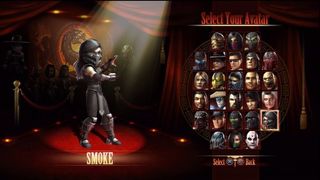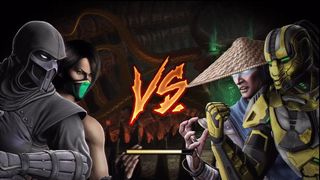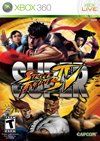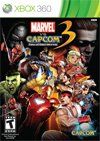Multiplayer just barely began working in time for this review, but what I played worked well. I was able to quickly hop into matches, find opponents, create lobbies and so on without issue, though something akin to SFIV’s fight request feature would have been a nice idea to copy as well. Perhaps the most interesting mode is “King of the Hill,” which takes SFIV’s Endless Match concept (two players fight, the rest spectate and chat and the winner stays on top) and adds Xbox Avatars (on 360) or chibi-MK fighter avatars (on PS3) along the bottom of the screen to act as you “watching” the match.

Above: What no Home support, PS3?
The true state of multiplayer won’t be known until thousands of people are all online, pushing the servers to their limit. But the time I spent suggested basic, functional ideas with the usual leaderboards and tracking info. And if you were wondering, no, online matches do not award combat coins. Excuse me, kombat koins.
On top of all this is the Tag mode, which most other games save for a whole other $60 sequel. In Tag matches, you select two fighters and, as you imagine, swap them in and out at will. While it’s not as robust as MvC, Tag mode does contain all the basics of a fun team experience. You can tag in a fighter mid-combo, call your friend in for an assist or quick-tag with an attack move/tag combo. It’s a great freebie that extends the combo and strategy opportunities well beyond what the single player game could offer, so the fact it’s here at all is noteworthy. Furthermore, up to four people can play tag mode, which assigns each player their own character. A cool idea, for sure, anda great way to further the "team" mindset.

Above: Picking a team isn’t as important a choice as in MvC, but hey, they didn’t have to include the mode at all
It all boils down to a great fighter that’s held back by a handful of serious issues. While I commend NetherRealm for making this one so easy to get into (you can even pause after “Finish Him!” and look up the fatality), the fight mechanics fall shy of contemporary fighters. I already mentioned the handful of oddities with hitboxes and priorities, but there’s also a problem with projectile attacks – there’s next to no cooldown between moves, so you can spam them all day. Some characters, like Mileena and Cyrax, can fill the screen with crap you can barely get around, and not in a challenging “I can figure this out” kind of way. It all feels unbalanced, in that half the characters can spam moves that are hard to react to, let alone punish when whiffed.
But again, most of us won't judge the game like that.It's still a blast to play for fun, and the story mode fully entertained me; hell, that thing’s 5-6 hours by itself, which is what most $60 games charge for anyway these days. And perhaps the biggest compliment I can give the new MK is that the violence actually garnered multiple "whoa!" and "ooooh shit!" remarks from everyone in the office, years after the series (and violent games in general) stopped impressing anyone. That's the true spirit of MK, and in that regard, this game completely lives up to its pedigree.
Is it better than...

Super SFIV? No. I’ve made comparisons to this throughout the review, and the bottom line is that SSFIV is a more thought-out fighter with finely balanced gameplay, useful training modes and special moves that change the flow of a match on a second-by-second basis. It lacks the story and theatrics of MK, but the gameplay is second to none. And if you're wondering why I keep bringing SF up, it's because these two series are the most widely recognized fighting games in the world, and they've been connected since their '90s arcade roots. Yin and yang, always.

Marvel vs Capcom 3? We’ll say no, but the experiences are so vastly different it’s hardly worth making the comparison. Sure MK has a tag mode, but it’s comparatively bare bones when compared to the nuanced team mechanics of any MvC, let alone part three. Then again, if you don’t want to deal with head-spinning 80-hit combos, MK could be more up your alley.

MK vs DC Universe? Yes. This was the last entry for MK, and while it’s a perfectly OK game in its own right, it is not a great MK game and does neither license justice. Once you get past the “oh hey, Batman is punching Sub-Zero in the face” aspect, you’re left with a fighter that came and went in the span of a month or two. MK 2011 stands a much better chance at a long life.
Just for you, Metacritic!
A successful sequel that both reboots and redeems the wayward series, though it’s not a flawless victory. Character balance, inconsistent detection and a stingy coin reward system drag down an otherwise bloody good time.


